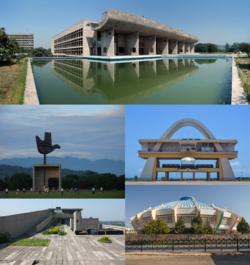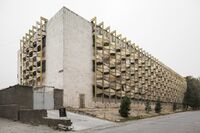New Mina: Difference between revisions
No edit summary |
No edit summary |
||
| (8 intermediate revisions by 3 users not shown) | |||
| Line 4: | Line 4: | ||
| native_name_lang = <!-- ISO 639-2 code e.g. "fr" for French. If more than one, use {{lang}} instead --> | | native_name_lang = <!-- ISO 639-2 code e.g. "fr" for French. If more than one, use {{lang}} instead --> | ||
| settlement_type = City | | settlement_type = City | ||
| image_skyline = | | image_skyline = NewMinaCollage.png | ||
| image_alt = | | image_alt = | ||
| image_caption = | | image_caption = Clockwise from top left: [[Palace of the Republic]], [[Black Star Square]], [[Union Theater]], [[Museum of Bahian Art (New Mina)|Museum of Bahian Art]], [[Unity Monument]] | ||
| image_flag = New Mina flag.png | | image_flag = New Mina flag.png | ||
| flag_alt = | | flag_alt = | ||
| Line 112: | Line 112: | ||
}} | }} | ||
'''New Mina''' (Gaullican: ''La Nouvelle-Mina''), also known as '''Mukoma''' in veRwizi (its official name from 1954 to | '''New Mina''' (Gaullican: ''La Nouvelle-Mina''), also known as '''Mukoma''' in veRwizi (its official name from 1954 to 1970) is a {{wp|planned city}} in [[Garambura]]. It lies directly south of [[Maware]], with which it forms the Maware-New Mina Urban Zone, and is part of Maware Province. As of 2020, New Mina has a population of 298,114, with the second highest rate of immigration into the city behind [[Mambiza]]. New Mina was shortlisted for the capital of Garambura in 1970, but ultimately lost out to [[Mutimukuru]] on the southern coast. | ||
While the site of New Mina had been settled for hundreds of years as villages south of Maware, it began as a planned capital of the [[United Bahian Republic]] in 1954. Djedi architect [[ | While the site of New Mina had been settled for hundreds of years as villages south of Maware, it began as a planned capital of the [[United Bahian Republic]] in 1954. Djedi architect [[Ahmad Abdelmalek]] was chosen to design the city, which was to feature infrastructure to house the governmental institutions of the United Bahian Republic and the subsequent population influx in and out of the city that would come with a designated capital. New Mina was renowned for its ambitious modernist architecture, which reflected the architectural scene of post-war Mina, hence its name. The city was officially opened and incorporated in 1968, however the necessary arrangements to move the central capital to New Mina were not completed before the Republic fell apart as a result of the [[Tabora|Taboran]] declaration of independence in 1964 and the subsequent [[Garamburan War of Independence]] in 1969. | ||
New Mina is home to the largest community of Orthodox Beheirans outside of [[Djedet]], with an estimated population of 180,000 within the city, over 50% of its total demographic. New Mina is the seat of the [[Patriarchate of Baséland]], the Orthodox denomination of [[Garambura]], and is home to many Orthodox churches. New Mina's unique blend of religious symbolism with modernist architecture has led it to be called one of the most culturally unique cities in the world. | New Mina is home to the largest community of Orthodox Beheirans outside of [[Djedet]], with an estimated population of 180,000 within the city, over 50% of its total demographic. New Mina is the seat of the [[Patriarchate of Baséland]], the Orthodox denomination of [[Garambura]], and is home to many Orthodox churches. New Mina's unique blend of religious symbolism with modernist architecture has led it to be called one of the most culturally unique cities in the world. | ||
== History == | == History == | ||
Ideas for a purpose-constructed capital city in [[Bahia]] existed for decades before New Mina began construction. [[Daniel Amankose]] put forward the idea of a newly-constructed capital near [[Bertholdsville]] (now [[Ouagedji]]) in [[Mabifia]] at the [[Conference for the Promotion of the Pan-Bahian Idea]] in 1907. Subsequent [[Pan-Bahianism|pan-Bahianists]] expanded on this idea throughout the 1910s and 1920s, but the idea of building the capital next to the city of [[Maware]] came about as the work [[Samhuri Ngonidzashe]] in 1946. Ngonidzashe chose Maware for the site of the new capital of the [[United Bahian Republic]] due to its history as one of the pre-eminent Mijini of the [[Dayira]] system in medieval Bahia. | |||
Construction began on the city in 1954 under [[Ihram|Ihrami]] architects Ahmad Abdelmalek and Berhan Habash. They sought to reflect the cultural diversity of Bahia in the city's construction and did so by designing separate parts of the city after a multitude of Bahian cultures, an influence which can still be seen today. The city was incorporated in 1968, but never officially served as the capital of the UBR due to prior member states leaving and [[Garamburan War of Independence|Garambura's declaration of independence]] under [[Takakunda Kuda Kani]] in 1969. After the [[Treaty of Bazadavo]], the city was renamed to New Mina in 1970, part of a greater 1970 trend of renaming cities in Garambura, after the birthplace of lead architect Abdelmalek in Ihram. Immigration into New Mina was the second highest in Garambura between 1969 and 1985, behind only [[Mambiza]] as the city's population skyrocketed to 150,000 by 1990. Over 50% of these immigrants practised Orthodox Sotirianity, and the city hosts most of Garambura's orthodox population, as well as being the seat of the Patriarchate of Baséland. The city also hosts a sizable [[Mirites|Mirite]] demographic, around 15,000 total, representing some 75% of Garambura's total Mirite population. | |||
The city's population hit 200,000 in 1998, and in 2000 surpassed neighbouring city Maware in population, becoming the third largest city in Garambura behind [[Mambiza]] and [[Makumba]]. In 2001 New Mina's two [[National Assembly (Garambura)|National Assembly]] districts were split into four, and have since represented over six different parties in their time together. New Mina has one of the highest political parties per capita of all cities in Bahia, and it has been renowned for its political framework and commitment to political discourse. The Unity Theatre hosted the Uwineza Music Festival in 2004 and 2006, massively boosting the local economy. The New Mina{{ndash}}Berhan Habash Airport opened in 2007, and a highway from the city to Kuwira began construction in 2009 to alleviate the infrastructural isolation the city faced in the east of the country. In 2016 the city was voted as the cleanest city in Bahia and in 2017 it received the Amsalu Development Award from the [[Congress of Bahian States]] for exceptional commitment to development. Gaullican president [[Jean Vallette]] visited the city in 2020 as part of an official state visit to Garambura, becoming the first Euclean head-of-state to step foot in the city. | |||
== Geography == | == Geography == | ||
New Mina sits directly opposite to the Maware Hills, the dominant natural feature in the area. The Ka-Mbatlo, Kwalubilo and Bodweni rivers sit nearby the city, although it is not situated on a river like its neighbouring city Maware. The area where New Mina is today was first explored, documented and mapped extensively by [[Didier Maxime Rhissassi]], whose expedition during the 1870s provided the first detailed maps of the area. Apart from the Maware Hills, the area is generally flat. | |||
=== Climate === | === Climate === | ||
== Architecture == | == Architecture == | ||
[[File:Capitol High Court.jpg|200px|thumb|right|The [[High Court of the Republic]] is known for its cantilevered double-roof]][[File:RandomveRewiziDistrictApartment.jpg|200px|thumb|right|Apartment building in the veRwizi District.]] New Mina was designed by a team of 42 architects from the state-owned [[Union of Architects of Djedet]] under the direction of [[Ahmad Abdelmalek]] and [[Berhan Habash]]. Having studied under the Gaullican modernist [[Louis Grandin]], Abdelmalek designed New Mina as the first "Socialist city" of a united Bahia. Designed in accordance to modernist principles of urban planning, Abdelmalek and Habash designed the city as a collection of 40 self-sufficient blocks divided into 10 districts. Every district had a designated area for schools, clinics, and stores. Every block consisted of a continuous arrangement of apartment buildings surrounding an internal courtyard intended for green space. Of the 40 blocks, only half were ever built. | |||
Every district was designed after a region of Bahia. Hoping to reflect Bahia's cultural diversity in the design of New Mina, Abdelmalek and his team worked with artists and designers from across the continent to fuse the austere language of modernism with traditional Bahian architecture. In the Djedet District, arabesque flourishes and intricate geometric patterns adorn apartment buildings. Buildings in the veRwizi District feature honeycomb windows and murals of traditional Sisulu shield patterns. In the Kambou District, windows were organized to form triangular configurations from traditional tengaade hats. | Every district was designed after a region of Bahia. Hoping to reflect Bahia's cultural diversity in the design of New Mina, Abdelmalek and his team worked with artists and designers from across the continent to fuse the austere language of modernism with traditional Bahian architecture. In the Djedet District, arabesque flourishes and intricate geometric patterns adorn apartment buildings. Buildings in the veRwizi District feature honeycomb windows and murals of traditional Sisulu shield patterns. In the Kambou District, windows were organized to form triangular configurations from traditional tengaade hats. | ||
Latest revision as of 00:55, 24 August 2021
New Mina
| |
|---|---|
City | |
 Clockwise from top left: Palace of the Republic, Black Star Square, Union Theater, Museum of Bahian Art, Unity Monument | |
| Etymology: Mina, Djedet | |
| Country | Garambura |
| Province | Maware |
| Construction began | 1954 |
| Incorporated | 1968 |
| Renamed New Mina | 1970 |
| Government | |
| • Governor | Taropafadzwa Mutawa |
| Area | |
| • Urban | 380.23 km2 (146.81 sq mi) |
| • Metro | 591 km2 (228 sq mi) |
| Population (2020) | |
| • City | 298,114 |
| Time zone | UTC+4 (Eastern Bahian Time) |
| Website | cityofnewmina |
New Mina (Gaullican: La Nouvelle-Mina), also known as Mukoma in veRwizi (its official name from 1954 to 1970) is a planned city in Garambura. It lies directly south of Maware, with which it forms the Maware-New Mina Urban Zone, and is part of Maware Province. As of 2020, New Mina has a population of 298,114, with the second highest rate of immigration into the city behind Mambiza. New Mina was shortlisted for the capital of Garambura in 1970, but ultimately lost out to Mutimukuru on the southern coast.
While the site of New Mina had been settled for hundreds of years as villages south of Maware, it began as a planned capital of the United Bahian Republic in 1954. Djedi architect Ahmad Abdelmalek was chosen to design the city, which was to feature infrastructure to house the governmental institutions of the United Bahian Republic and the subsequent population influx in and out of the city that would come with a designated capital. New Mina was renowned for its ambitious modernist architecture, which reflected the architectural scene of post-war Mina, hence its name. The city was officially opened and incorporated in 1968, however the necessary arrangements to move the central capital to New Mina were not completed before the Republic fell apart as a result of the Taboran declaration of independence in 1964 and the subsequent Garamburan War of Independence in 1969.
New Mina is home to the largest community of Orthodox Beheirans outside of Djedet, with an estimated population of 180,000 within the city, over 50% of its total demographic. New Mina is the seat of the Patriarchate of Baséland, the Orthodox denomination of Garambura, and is home to many Orthodox churches. New Mina's unique blend of religious symbolism with modernist architecture has led it to be called one of the most culturally unique cities in the world.
History
Ideas for a purpose-constructed capital city in Bahia existed for decades before New Mina began construction. Daniel Amankose put forward the idea of a newly-constructed capital near Bertholdsville (now Ouagedji) in Mabifia at the Conference for the Promotion of the Pan-Bahian Idea in 1907. Subsequent pan-Bahianists expanded on this idea throughout the 1910s and 1920s, but the idea of building the capital next to the city of Maware came about as the work Samhuri Ngonidzashe in 1946. Ngonidzashe chose Maware for the site of the new capital of the United Bahian Republic due to its history as one of the pre-eminent Mijini of the Dayira system in medieval Bahia.
Construction began on the city in 1954 under Ihrami architects Ahmad Abdelmalek and Berhan Habash. They sought to reflect the cultural diversity of Bahia in the city's construction and did so by designing separate parts of the city after a multitude of Bahian cultures, an influence which can still be seen today. The city was incorporated in 1968, but never officially served as the capital of the UBR due to prior member states leaving and Garambura's declaration of independence under Takakunda Kuda Kani in 1969. After the Treaty of Bazadavo, the city was renamed to New Mina in 1970, part of a greater 1970 trend of renaming cities in Garambura, after the birthplace of lead architect Abdelmalek in Ihram. Immigration into New Mina was the second highest in Garambura between 1969 and 1985, behind only Mambiza as the city's population skyrocketed to 150,000 by 1990. Over 50% of these immigrants practised Orthodox Sotirianity, and the city hosts most of Garambura's orthodox population, as well as being the seat of the Patriarchate of Baséland. The city also hosts a sizable Mirite demographic, around 15,000 total, representing some 75% of Garambura's total Mirite population.
The city's population hit 200,000 in 1998, and in 2000 surpassed neighbouring city Maware in population, becoming the third largest city in Garambura behind Mambiza and Makumba. In 2001 New Mina's two National Assembly districts were split into four, and have since represented over six different parties in their time together. New Mina has one of the highest political parties per capita of all cities in Bahia, and it has been renowned for its political framework and commitment to political discourse. The Unity Theatre hosted the Uwineza Music Festival in 2004 and 2006, massively boosting the local economy. The New Mina–Berhan Habash Airport opened in 2007, and a highway from the city to Kuwira began construction in 2009 to alleviate the infrastructural isolation the city faced in the east of the country. In 2016 the city was voted as the cleanest city in Bahia and in 2017 it received the Amsalu Development Award from the Congress of Bahian States for exceptional commitment to development. Gaullican president Jean Vallette visited the city in 2020 as part of an official state visit to Garambura, becoming the first Euclean head-of-state to step foot in the city.
Geography
New Mina sits directly opposite to the Maware Hills, the dominant natural feature in the area. The Ka-Mbatlo, Kwalubilo and Bodweni rivers sit nearby the city, although it is not situated on a river like its neighbouring city Maware. The area where New Mina is today was first explored, documented and mapped extensively by Didier Maxime Rhissassi, whose expedition during the 1870s provided the first detailed maps of the area. Apart from the Maware Hills, the area is generally flat.
Climate
Architecture

New Mina was designed by a team of 42 architects from the state-owned Union of Architects of Djedet under the direction of Ahmad Abdelmalek and Berhan Habash. Having studied under the Gaullican modernist Louis Grandin, Abdelmalek designed New Mina as the first "Socialist city" of a united Bahia. Designed in accordance to modernist principles of urban planning, Abdelmalek and Habash designed the city as a collection of 40 self-sufficient blocks divided into 10 districts. Every district had a designated area for schools, clinics, and stores. Every block consisted of a continuous arrangement of apartment buildings surrounding an internal courtyard intended for green space. Of the 40 blocks, only half were ever built.
Every district was designed after a region of Bahia. Hoping to reflect Bahia's cultural diversity in the design of New Mina, Abdelmalek and his team worked with artists and designers from across the continent to fuse the austere language of modernism with traditional Bahian architecture. In the Djedet District, arabesque flourishes and intricate geometric patterns adorn apartment buildings. Buildings in the veRwizi District feature honeycomb windows and murals of traditional Sisulu shield patterns. In the Kambou District, windows were organized to form triangular configurations from traditional tengaade hats.
The administrative center of the United Bahian Republic was the Mukoma Capital Quarter at the north of New Mina. The Capitol Quarter is oriented around Liberation Square. At the north end of the square is the Palace of the Republic. Designed by Berhan Habash and Garamburan architect Muzukuru Mubako, the Palace is notable for its open-plan interior that offers the assembly hall an uninterrupted view of the Maware Hills. At the south end is the High Court of the Republic, designed with a cantilevered double roof that provides shade to the open-air lattice-work walkways that connect the building's segregated sections. At the east end is the Grand Secretariat, home to the headquarters of the UBR. The Secretariat features a façade adorned by a rhythmic arrangement of abstract patterns and sun-breaks. The square and its buildings were designed as a harmonious ensemble that would set the stage for Bahia's Socialist future. The Federation Tower at the west end was a recent addition designed by Mubako in 1960.


